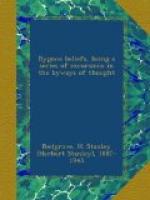Goety, or black magic, was concerned with the evocation of demons and devils—spirits supposed to be superior to man in certain powers, but utterly depraved. Sorcery may be distinguished from witchcraft, inasmuch as the sorcerer attempted to command evil spirits by the aid of charms, etc., whereas the witch or wizard was supposed to have made a pact with the Evil One; though both terms have been rather loosely used, “sorcery” being sometimes employed as a synonym for “necromancy”. Necromancy was concerned with the evocation of the spirits of the dead: etymologically, the term stands for the art of foretelling events by means of such evocations, though it is frequently employed in the wider sense.
It would be unnecessary and tedious to give any detailed account of the methods employed in these magical arts beyond some general remarks. Mr A. E. WAITE gives full particulars of the various rituals in his Book of Ceremonial Magic (1911), to which the curious reader may be referred. The following will, in brief terms, convey a general idea of a magical evocation:—
Choosing a time when there is a favourable conjunction of the planets, the magician, armed with the implements of magical art, after much prayer and fasting, betakes himself to a suitable spot, alone, or perhaps accompanied by two trusty companions. All the articles he intends to employ, the vestments, the magic sword and lamp, the talismans, the book of spirits, etc., have been specially prepared and consecrated. If he is about to invoke a martial spirit, the magician’s vestment will be of a red colour, the talismans in virtue of which he may have power over the spirit will be of iron, the day chosen a Tuesday, and the incense and perfumes employed of a nature analogous to Mars. In a similar manner all the articles employed and the rites performed must in some way be symbolical of the spirit with which converse is desired. Having arrived at the spot, the magician first of all traces the magic circle within which, we are told, no evil spirit can enter; he then commences the magic rite, involving various prayers and conjurations, a medley of meaningless words, and, in the case of the black art, a sacrifice. The spirit summoned then appears (at least, so we are told), and, after granting the magician’s request, is licensed to depart—a matter, we are admonished, of great importance.




